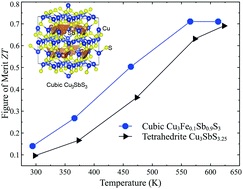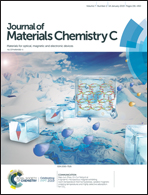Crystal structure and improved thermoelectric performance of iron stabilized cubic Cu3SbS3 compound
Abstract
Cu3SbS3 is a copper-based thermoelectric (TE) sulfide with strong vibrational anharmonicity, and it is a member of the Cu–Sb–Se system with lone pair electrons on the Sb sites and three-coordinated Cu ions exhibiting a large vibrational amplitude. However, a phase transition within the working temperature range will inevitably deteriorate the joint between the TE legs and substrates. Here, we successfully stabilized its less-known cubic structure by incorporating Fe atoms into Cu3SbS3. Phase structure analysis showed that the cubic structure is similar to that of the well-known tetrahedrite (Cu3SbS3.25), with the S atom at the centre of the unit cell missing. The thermodynamic stability and phase evolution of the materials were studied up to 623 K in both air and Ar atmospheres. The improved TE performance and the electron band structure were also identified and correlated. All results indicated that cubic Cu3SbS3 cannot be regarded as a derivative of S-deficient tetrahedrite, and theoretical modeling revealed its unique electron band structure. Benefiting from the low thermal conductivity, the Cu3Fe0.1Sb0.9S3 sample shows a higher zT than tetrahedrite in the whole testing temperature range, with a maximum of 0.70 being achieved around 550–625 K. Our results firmly demonstrate the possibility of stabilising the cubic structure of Cu3SbS3 by Fe incorporation and highlight it as a strong candidate for high performance TE materials.



 Please wait while we load your content...
Please wait while we load your content...